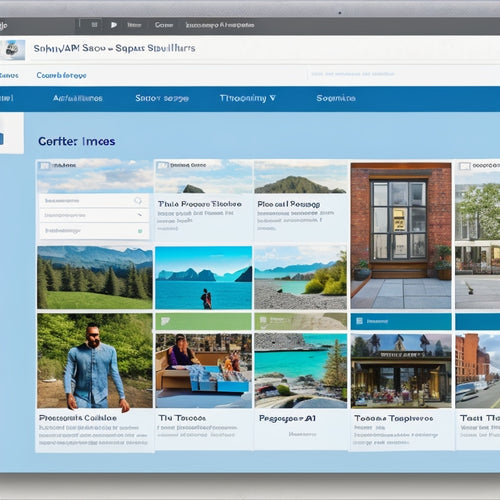
What's Holding Back Your Online Sales Growth?
Share
You're struggling to boost your online sales, and it's likely due to one of several common pitfalls. For instance, your sales team may lack relevant training, with only 12% of programs offering e-commerce specific content. Or, your marketing strategy might be insufficient, with 60% of businesses under allocating budget to digital channels. Perhaps your sales funnel has leaky conversion points, or your video content fails to captivate the audience. Whatever the case, identifying these weaknesses is essential to accessing growth. Now, take a closer look at your strategy to uncover the root causes holding you back from achieving online sales success.
Key Takeaways
• A lack of relevant course content and poorly structured learning experiences hinder sales teams' ability to adapt to the e-commerce landscape.
• Insufficient marketing strategies, including inadequate budgets and unengaging video content, fail to capture target audiences and drive online sales growth.
• Ineffective sales funnel design, including leaky conversion points and misaligned value propositions, leads to lost customers and missed opportunities.
• Difficulty in building trust and limited post-sale engagement result in stagnant sales growth and poor customer retention rates.
• Unoptimized course pricing strategies and inadequate student support systems lead to low engagement, high dropout rates, and negative reviews.
Lack of Relevant Course Content
Only 12% of online sales training programs provide relevant course content that adequately prepares sales teams to capitalize on the rapidly evolving e-commerce landscape. As a result, you're likely struggling to equip your team with the skills they need to succeed in today's digital marketplace.
To overcome this challenge, you need to prioritize content curation that speaks directly to your target audience. This means tailoring your training programs to address the unique pain points and challenges your sales team faces every day. By doing so, you'll be able to arm them with the knowledge and expertise they need to drive online sales growth and stay ahead of the competition.
It's time to take a closer look at your current training programs and ask yourself: Are they relevant, engaging, and effective? Are they aligned with the needs and goals of your target audience? By answering these questions and making adjustments accordingly, you can create a sales team that's truly equipped to thrive in the world of e-commerce.
Poorly Structured Learning Experience
When you're stuck with a poorly structured learning experience, you're likely to struggle with unclear goals, insufficient guided practice, and inadequate content organization.
These issues will hinder your progress and make it tough to achieve your online sales growth objectives.
Lack of Clear Goals
You'll struggle to achieve online sales growth if you don't set clear goals, as a poorly structured learning experience leaves you without direction or focus. Without a clear roadmap, you'll wander aimlessly, wasting resources and time on ineffective strategies.
Unclear objectives lead to ineffective strategies, causing you to spread yourself too thin and failing to make meaningful progress.
Here are just a few consequences of lacking clear goals:
-
Undefined targets: You won't know what you're working towards, making it impossible to measure success.
-
Missed opportunities: Without clear goals, you'll overlook potential growth areas and fail to capitalize on them.
-
Inefficient resource allocation: You'll waste time and money on initiatives that don't drive meaningful results.
- Lack of accountability: Without clear goals, you won't have a benchmark to hold yourself or your team accountable.
Insufficient Guided Practice
How can you expect to drive online sales growth if your learning experience lacks guided practice, leaving you to navigate the complex world of e-commerce without a clear plan or expert guidance? You're basically flying blind, relying on trial and error to figure out what works and what doesn't. This approach not only wastes valuable time and resources but also hinders your ability to scale your online business.
| Guided Practice | Unstructured Learning |
|---|---|
| Interactive simulations | Random experimentation |
| Targeted feedback | No expert guidance |
| Clear plan of action | Trial and error approach |
Without guided practice, you're missing out on the opportunity to refine your skills and gain confidence in your abilities. You need a structured learning experience that provides interactive simulations, targeted feedback, and a clear plan of action. This will enable you to develop the expertise you need to drive online sales growth and stay ahead of the competition. By incorporating guided practice into your learning experience, you'll be able to overcome the obstacles that are holding you back and achieve the success you deserve.
Inadequate Content Organization
Without a clear and logical framework, the wealth of information available to you is rendered useless, leaving you to sift through a jumbled mess of disconnected concepts and struggle to make sense of it all. This is what happens when you neglect content organization. Your customers are left frustrated and confused, ultimately leading to a decline in online sales growth.
To avoid this, you need to prioritize content categorization and user navigation. This means creating an information hierarchy that makes sense, allowing your customers to easily find what they're looking for. Here are a few key strategies to get you started:
-
Create clear and concise category labels that align with your customers' thought processes
-
Use a logical website structure that funnels customers towards conversion
-
Implement a robust search function that returns relevant results
- Use visual cues like icons and images to break up large blocks of text and guide the customer's eye
Insufficient Marketing Strategy
Inadequate marketing strategies hinder online sales growth, as evidenced by the 60% of businesses that fail to allocate sufficient budget to digital marketing channels. You're likely part of this statistic if you're struggling to drive conversions. Take a step back and assess your marketing approach.
Are you targeting the right audience? Are your digital advertising efforts resonating with them? If not, it's time to revamp your strategy.
Start by identifying your targeted audience and creating buyer personas. This will help you understand their pain points, preferences, and behaviors. Next, allocate your budget to digital advertising channels that align with your audience's online habits.
For instance, if your target audience is active on social media, consider running targeted ads on Facebook or Instagram. By doing so, you'll increase brand visibility, drive website traffic, and ultimately, boost online sales.
Unengaging Video Content Quality
You're likely turning off potential customers with subpar video content that fails to captivate their attention, as 85% of businesses report using video as a marketing tool, yet only 15% see significant engagement. This is a staggering statistic, especially considering the potential of video to drive improved engagement and sales. So, what's going wrong?
Here are a few common mistakes that might be holding you back:
-
Lack of clear goals: Are you creating videos just for the sake of creating videos, or do you have a clear objective in mind?
-
Poor production quality: Is your video content poorly lit, with bad sound quality or low-resolution visuals?
-
Uncompelling storytelling: Are you failing to connect with your audience through compelling storytelling and emotional resonance?
- Inconsistent publishing schedule: Are you leaving your audience hanging, waiting for your next video to drop?
Ineffective Sales Funnel Design
When you analyze your sales funnel, you'll likely find that it's not converting as well as you'd like, and that's often due to two key issues: leaky conversion points and a misaligned value proposition.
These problems can silently sabotage your online sales growth, causing potential customers to drop off at critical stages.
Leaky Conversion Points
Identify and plug the holes in your sales funnel, as a staggering 70% of online businesses lose customers at some point between browsing and buying, due to poorly designed conversion points that fail to resonate with potential customers. These leaks can be devastating to your sales growth, but the good news is that you can fix them with some conversion optimization strategies.
Here are some common leaky conversion points to investigate:
-
Forms that are too long or complicated, causing friction and abandonment
-
Calls-to-action (CTAs) that are unclear, misleading, or hard to find
-
Slow page loading times, leading to frustrated users and high bounce rates
- Lack of social proof, trust badges, or customer testimonials to build credibility
Misaligned Value Proposition
Approximately 80% of online businesses struggle with misaligned value propositions, which silently sabotage their sales funnels by failing to communicate a clear, compelling reason for customers to buy.
You're likely among them if you're experiencing stagnant sales growth. A misaligned value proposition occurs when your brand messaging doesn't resonate with your target audience, leading to a disconnect in customer perception.
To realign your value proposition, you need to understand your customers' pain points, desires, and motivations. Conduct surveys, gather feedback, and analyze your competition to identify areas of differentiation.
Then, craft a unique value proposition that speaks directly to your target audience's needs. Make sure your messaging is consistent across all touchpoints, from social media to your website and ads.
Difficulty in Building Trust
Building trust with online customers is tough, especially since 85% of them admit to being more cautious when making online purchases due to fears of fraud or misinformation. You're not alone in this struggle, but you can't afford to ignore it. Without trust, you'll struggle to convert visitors into customers.
To overcome this hurdle, focus on the following trust-building tactics:
-
Showcase customer testimonials and reviews to demonstrate social proof and credibility.
-
Be transparent about your business practices, shipping, and return policies.
-
Use security badges and trust marks to alleviate concerns about fraud and data protection.
- Offer a satisfaction guarantee to give customers confidence in their purchase.
Limited Post-Sale Engagement
You've worked hard to earn that first sale, but now you're facing a new challenge: limited post-sale engagement, which can lead to a 67% drop in customer retention rates. This is a critical moment, as the lack of engagement can turn your customers into one-time buyers instead of loyal advocates.
To avoid this, prioritize post-sale follow-up and customer engagement. Send personalized emails or surveys to gather feedback and show customers you value their opinions. This helps build trust and increases customer satisfaction.
Implementing retention strategies such as loyalty programs, exclusive offers, or early access to new products can also drive repeat business. By focusing on customer satisfaction, you can increase retention rates and encourage positive word-of-mouth.
Unoptimized Course Pricing Strategy
One in five online courses fail to generate significant revenue due to an unoptimized pricing strategy, which can stagnate growth and undermine profitability. As an online course creator, you might be leaving money on the table by not optimizing your pricing strategy. Finding the right balance between revenue potential and customer affordability is crucial.
Here are some common mistakes to avoid:
-
Not segmenting your audience: Failing to differentiate between various customer segments and offering a one-size-fits-all price can result in lost sales.
-
Not considering the competition: Disregarding your competitors' pricing strategies can lead to your course being either overpriced or underpriced.
-
Not testing pricing tiers: Neglecting to experiment with different pricing tiers can result in missing potential revenue.
- Not adjusting for perceived value: Failing to consider the perceived value of your course can leave customers feeling it's either overpriced or underpriced.
Inadequate Student Support System
How much revenue is your online course losing due to frustrated students who can't get the help they need? You invested time and resources into creating a high-quality course, but if students can't access the support they require, they'll quickly lose interest and drop out.
| Support System | Impact on Student Engagement |
|---|---|
| Lack of Communication | Students feel isolated and disconnected, resulting in low engagement and high dropout rates |
| Inadequate Resources | Students struggle to find answers, leading to frustration and disengagement |
| Unresponsive Support Team | Students feel ignored, resulting in negative reviews and a damaged reputation |
An insufficient student support system can be a significant obstacle to online sales growth. To overcome this, you need to prioritize student engagement and communication. Guarantee your support team is responsive and has the resources they require to provide timely and effective support. By doing so, you'll increase student satisfaction, reduce dropout rates, and ultimately drive revenue growth. Don't let an insufficient support system hold you back – invest in your students' success and watch your online course thrive.
Frequently Asked Questions
How Do I Measure the Success of My Online Sales Strategy?
You measure the success of your online sales strategy by tracking key performance indicators like conversion rate analysis, which reveals areas for improvement, and adjusting your approach accordingly to maximize ROI and drive growth.
What Is the Ideal Length for My Online Course Videos?
"Picture your viewers' attention span as a fleeting spark - you've got 3-5 minutes to fan it into engagement. Keep your online course videos concise, and you'll see a boost in content engagement and viewer retention, driving sales growth."
Can I Use Social Media to Promote My Online Course?
You can leverage social media to promote your online course by sparking engagement through relevant content, identifying and targeting your ideal audience, and driving outreach through influencer partnerships and paid ads.
How Often Should I Update My Online Course Content?
'Frequently fuel new fascination by regularly updating your online course content, leveraging user feedback and analytics to boost engagement, and strategically spacing updates to sustain students' curiosity and craving for new knowledge.'
Do Refunds Impact My Online Course's Credibility?
You set refund policies to prioritize customer satisfaction, not harm credibility. In fact, transparent policies boost trustworthiness, as they show you stand behind your online course's value, ultimately protecting your reputation.
Related Posts
-

Why Optimal Pricing Matters for Online Learning Success
You set your online course prices, but ultimately, they set the tone for your students' perception of value, engageme...
-

How Do I Set up A Tracking Page on Shopify
This article aims to provide a comprehensive guide on setting up a tracking page on the Shopify platform. It explore...

